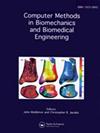跗骨中关节刚度通过一些机制改变模拟跑步的代谢成本,而不是通过足部能量储存和返回的变化。
IF 1.7
4区 医学
Q3 COMPUTER SCIENCE, INTERDISCIPLINARY APPLICATIONS
Computer Methods in Biomechanics and Biomedical Engineering
Pub Date : 2025-06-14
DOI:10.1080/10255842.2025.2514794
引用次数: 0
摘要
有人提出足弓有助于提高跑步的代谢效率。计算肌肉骨骼模拟稳态后脚和非后脚撞击在一系列跗骨中关节(即足弓)的刚度表明,随着刚度的增加,后脚撞击跑步的代谢运输成本降低了约5%,但在非后脚撞击跑步中增加了约11%。在两种跑步足撞击条件下,随着跗骨中关节刚度的增加,对其进行的机械功的大小遵循类似的减少模式,这表明除了足部能量储存和返回之外的机制是导致代谢成本变化的原因。本文章由计算机程序翻译,如有差异,请以英文原文为准。
Midtarsal joint stiffness alters the metabolic cost of simulated running via mechanisms other than changes in foot energy storage and return.
The foot's arch has been proposed to aid in metabolically efficient running. Computational musculoskeletal simulations of steady state rearfoot and non-rearfoot strike running across a range of midtarsal joint (i.e. foot arch) stiffnesses indicated that with increasing stiffness the metabolic cost of transport decreased by ∼5% in rearfoot strike running but increased by ∼11% in non-rearfoot strike running. The magnitude of mechanical work performed about the midtarsal joint as its stiffness increased followed a similar decreasing pattern in both running foot strike conditions, suggesting that mechanisms beyond foot energy storage and return were responsible for the altering metabolic cost.
求助全文
通过发布文献求助,成功后即可免费获取论文全文。
去求助
来源期刊
CiteScore
4.10
自引率
6.20%
发文量
179
审稿时长
4-8 weeks
期刊介绍:
The primary aims of Computer Methods in Biomechanics and Biomedical Engineering are to provide a means of communicating the advances being made in the areas of biomechanics and biomedical engineering and to stimulate interest in the continually emerging computer based technologies which are being applied in these multidisciplinary subjects. Computer Methods in Biomechanics and Biomedical Engineering will also provide a focus for the importance of integrating the disciplines of engineering with medical technology and clinical expertise. Such integration will have a major impact on health care in the future.

 求助内容:
求助内容: 应助结果提醒方式:
应助结果提醒方式:


